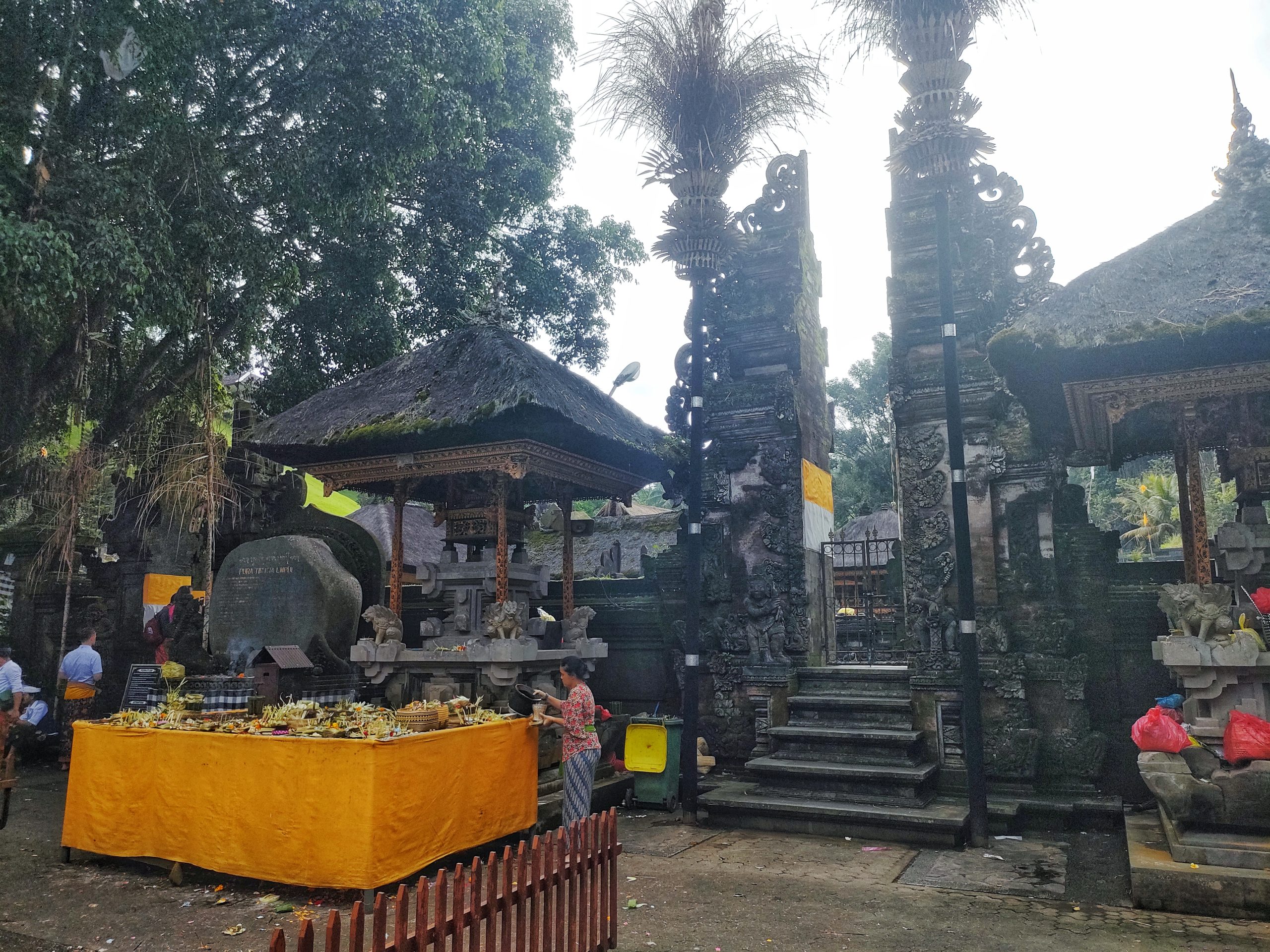Tirta Empul Temple locally known as Pura Tirta Empul (Holy Spring in Balinese) is located in the village of Manukaya, near the town of Tampaksiring, in central Bali.T he temple pond has a spring which gives out fresh water regularly, which Balinese Hindus consider to be holy or amritha where Balinese Hindus go to for ritual purification to cleanse their souls and ward off evil.

This tradition still continues almost unchanged, and today, aside from worshipers, tourists from all over the world also come to this place to marvel at its beauty, and bathe in its refreshing blessed water. Another nearby and prominent site on top of a hill is the presidential palace, Istana Tampaksiring, built during the years of the nation’s first president, Soekarno. Together with the Presidential Palace, the Tirta Empul Temple provide some of the most fascinating views you will ever see.

Where is Tirta Empul in Bali Address?
As mentioned above the Tirta Empul Temple is located in the village of Manukaya, Tampaksiring Distric, Gianyar Regency, Bali, Indonesia. The temple is situated just below the Presidential Palace of Tampaksiring. Built in 1957 by Indonesia’s first president, Soekarno, the beautifully built palace itself is an important landmark of the island and the country.
How do you get to Tirta Emplul Temple?
It’s pretty easy to get to the Tirta Empul Temple and can be reached by many sides besides from central town of Ubud, from eastern corner of Ubud and from southern area of Ubud. As the distance from Denpasar airport is around 54 kms, from Kuta around 50 kms, from Seminyak around 50 kms and from Ubud area around 30-minute drive to the north.
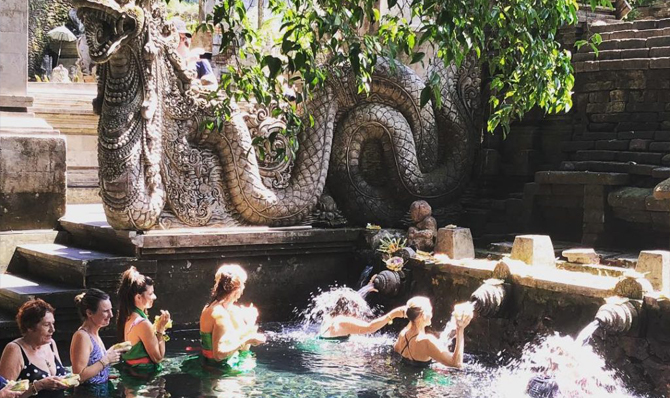
The best transport mode here is motorbike rental, However the safest way is renting car with driver to discover some attractions near by like; Kintamani Volcano, Ubud Monkey Forest, Tegalalang Rice Terraces, Goa Gajah, Tegenungan Waterfall, and much more. The route from Ubud is as follows: Ubud – Tampaksiring Street – continue to Ir. Soekarno Street -take the right turn to Tirta Street, where the temple is located.
Tirta Empul Temple Entrance Fee
Visit to the Tirta Empul Temple are subject to an entrance fee of 50,000 IDR per person for adult, and 25,000 IDR per person for kid. The ticket can be bought at the ticket counter which located just before the entrance gate and set away from the main road.
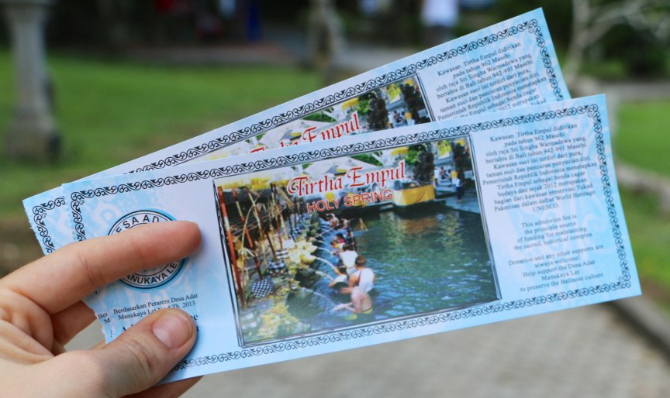
And the payment should be cash in Indonesian Rupiah (IDR), so please prepare small cash before you come here. There is no guides to assist you during your visit. So we recommed you to get guided tour which included the entrace fees, meal, and also can give you information about the temple.
Tirta Empul Temple Opening Hours
Like many of the temples around Bali, Tirta Empul is open seven days a week. The opening hours for the temple are between 9:00 am and 5:00 pm. Except in Nyepi day (Silence in Bali), where everything needs to stop.
Tirta Empul Temple Dress Code
As with any temple visit in Bali, it’s always important to dress respectfully. The simple Balinese temple visitor dress code is a traditional kamen wrap or sarong around the lower body plus a sash around the waist.
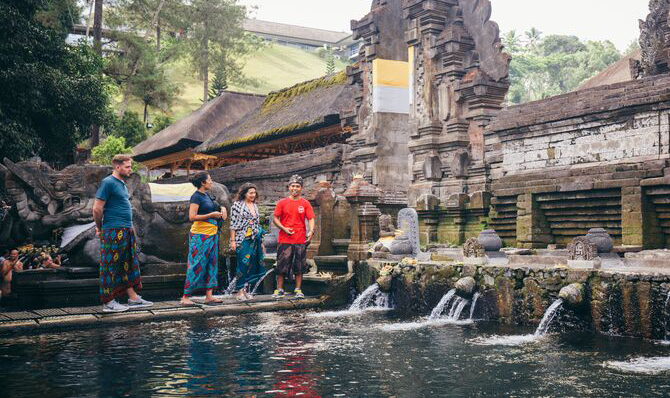
Planning to do the bathing ritual. Make sure to bring another sarong to change the wet one after the bath, and also you can rent a sarong for a small donation at the entrance to the temple. Women during their periods are prohibited entry to any temple or sacred site and may enjoy the sights and attractions in the outer perimeters only.
Tirta Empul Temple Facilities
As the busiest temple in the region, the Tirta Empul Temple has more than enough facilities. Bathroom and parking are available (one parking ticket Rp 5000). Lockers to put belonging while visitors bath available for rent. Each at Rp 10,000.

The front of the temple complex is a large parking area with art markets and rows of shops selling various curios and souvenirs lining its eastern side. You’ll also find several warungs or food stalls selling local food, snacks and refreshments.
What is the best time to visit Tirta Empul Temple?
Though it is advisable and seen that the evening visits especially on the full moon nights are truly mesmerizing and keep you spellbound, the best timings for Tirta Empul Temple visit is around 8 am to to 2 pm. This is a good time all through the yearly calendar as during morning visitor’s rush is rare and is very less. The earlier you arrive, the less likely are you to experince large crowds.
How Long You Should Spend in Tirta Empul Temple?
Tirta Empul is a large temple complex and it takes at least 45 minutes to an hour to explore the entire site. There are three parts to the temple, such as outer courtyard is called Jaba Pura, the center courtyard is called Jaba Tengah, and the inner courtyard is called Jeroan
What You Can Expect in Tirta Empul Temple?
As soon as you enter temple, you will walk through the large stone Balinese gate (locally known as Candi Bentar) and arrive in the outer courtyard of the temple. This area of the temple is called ‘Jaba Pura. At the end of the courtyard is another Candi Bentar built into the wall that leads to the central courtyard.

This gate is guarded by smoothly carved huge statues of two Dwarapala or guardians given a brush of golden colors. At the top of the gate is a carving of Kala which is quite different than other Kala carvings elsewhere since it has fangs that stick upwards and a pair of hands with open arms. Entering the inner courtyard, you will arrive at the ‘Jaba Tengah’ area which is the main area of the temple.

The holy springs here bubble up into a large, crystal-clear pool within the temple and gush out through 30 waterspouts into the two sacred purification pools. Local Balinese and Hindu worshippers stand in long lines in the pools waiting to dip their heads under the water spouts in a purification ritual known as ‘melukat’. Bathers start in the pool on the left side standing in the pool to the waist under the first water spout.

Once they have cleansed themselves under the first spout they join the next queue. This process is continued until they have cleansed themselves under each waterspout. However, there are two spouts that are meant only for cleansing the dead and are for prohibited to be used by the living for the ‘melukat‘ ritual. Behind the purification pools is the final section of the Tirta Empul Holy Water Temple, called the Jeroan.

Mostly overlooked by tourists, the jeroan or inner courtyard is a pleasant place to visit and relax after the hustle and bustle of the purification pools. This is where people come to pray. The front part of the courtyard is dominated by the large water spring that feeds the purification pools. The spring is filled with green algae and small fish swim among the reeds. Behind the springs are large Hindu shrines. This part of the temple is nice to quickly explore. The shrines are brightly decorated, which contrasts with the starched white clothing of the Balinese who come here to pray.

As you exit Tirta Empul Temple you pass through a large pool filled with koi fish.This section of the temple is walled off on all four sides from the rest of the complex, which gives it a calm and relaxing atmosphere. Fat koi swim lazily in the pond waiting for their next meal.
Tirta Empul Temple History & Legend of Creation
Tirta Empul Temple is one of the largest and busiest water temples in Indonesia. The temple was founded in 926 A.D. is a silent witness to the old Balinese kingdom, particularly at the time of the Warmadewa Dynasty.
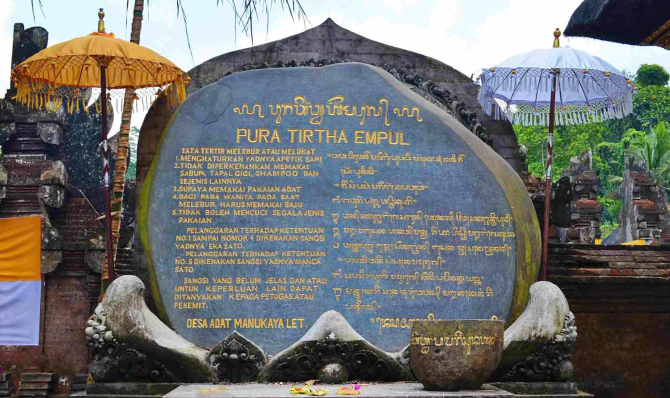
Besides the beautiful and the eye craving sights of this place, there are many myths and some of the true facts associated with this place. The Balinese believe that the creation of Tirta Empul Temple involves the legend of an epic battle between a powerful and magical king named Mayadenawa and the God Indra. Mayadenawa possessed the spiritual power to transform himself into any form he desired. But he became careless with his powers and used them for black magic.

A priest named Sang Kulputih prayed to the God Indra to put an end to the evil king. Indra and his soldiers managed to defeat Mayadenawa’s forces, and left the wicked king and what’s left of his troops running for their life.
Later, Mayadenawa snuck into Indra’s camp when the army slept. He created a beautiful but poisonous pond that the army would drink from upon waking up. When Mayadenawa crept into the camp, he walked on the sides of his feet so as not to leave footprints- thus this is believed to be the origin of the name ‘Tampak Siring’ which translates as ’tilted footprint’.
In the morning Indra awoke to find many of his men dead and scores more sick and dying. It was then, through his mighty power that the God Indra pierced the ground with his staff, creating the sacred healing springs of holy water which came to be known as Tirta Empul. Knowing that his plan had failed, Mayadenawa franticly tried to transform himself into all sorts of different beings but to no avail, since Indra continued to chase him. When at last he transformed himself into a boulder, Indra shot an arrow through it, pierced and eventually killed the evil king. The blood of Mayadenawa that gushed from the boulder is believed to have formed the Petanu River, and for over a thousand years, the river was cursed making rice to grow rapidly, but having an awful reek and tainted with blood. The Hindu Balinese commemorate the death of Mayadenawa every 210 days in the Balinese traditional calendar as the day when Virtue triumphs over Evil in the ritual and ceremony called Galungan.
What is there to do in Tirta Empul Temple?
1. Relax: Take a spiritual refreshment
Get soaked in the spiritual atmosphere of the temple. The people have known that the temple of this place is good for the spiritual awakening and relaxing of ones mind, body and soul.
This is a good option for you if you dont want to make each day of your trip very hectic then come early morning and sit and relax in this quiet place, this will surely get your inner being rejuvenated.
2. Click: Capture the captivating traces of past
Get the picturesque view of the temple in your captured memories for always. Each time you would have a very unique tale to tell when you go back to your pictures of the amazing and picturesque monuments of standing right in the middle of the water spring!
3. Connect: Interact with other visitors
Get to the point of meeting and relating with the people believing various facts and cultures. Being a tourist attraction, this place will help you get in touch with many of the people coming across from all over the world!
This gives you an immensely exciting opportunity to know more about what other land and cultures have to offer!
This not only increases your knowledge and inner peace but also makes your aware of how to distinguish between myths and the facts!
4. Melukat: Purification Ritual
A bathing ritual to clean one’s body and soul. For non-Hindu visitors, depending on each person’s spirituality.
Participating in a bath ritual here means either a spiritually rewarding experience. Or a simply refreshing bath on cold mountain water.
Either way, it’s just interesting to be part of this religious ritual. So, queue to get in the water and follow the examples of Balinese in front of you.
To perform Melukat ritual, one needs to dress in traditional sarong wrap around the body.
